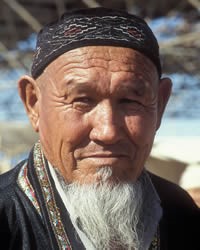Making and Maintaining a People Group List
Purpose of the Joshua Project Peoples List
The main purpose of the Joshua Project people group list is to support church planting (CP) efforts that result in church planting movements (CPM). The definition of a people group is: "For evangelization purposes, a people group is the largest group within which the Gospel can spread as a church planting movement without encountering barriers of understanding or acceptance" (Source: 1982 Lausanne Committee Chicago meeting.) For a list of data sources, click here.
Two Lists Combined to Make a Global List
The Joshua Project peoples list might be best viewed as two distinct people group lists that together provide a comprehensive global perspective. The first list is all people groups outside South Asia where people groups are generally defined by language or dialects i.e. ethno-linguistic. On this list understanding is the greatest barrier to the spread of the Gospel.
The Joshua Project peoples list might be best viewed as two distinct people group lists that together provide a comprehensive global perspective.
The second list is all the people groups in South Asia (India, Pakistan, Bangladesh, Nepal, Bhutan and Sri Lanka) where people groups are defined by the long-established traditional caste communities of the Asia sub-continent. This is how people in this part of the world self-identify at the deepest level. On this second list acceptance is the greatest barrier to the spread of the Gospel. These two lists have been combined to generate a global peoples list.
Assumptions – Where Understanding is the Most Significant Barrier
- Each language group will require at least one CP project, possibly more than one. Language groups will need more than one CP project if either (a) dialect differences are great, or (b) societal / relational / religious differences are great.
- A people group is to be identified for each language group and for each sub-division of language group that needs its own CP project. In addition, people groups not needing a CP project may optionally be included (such as expatriate groups) for the sake of completeness.
- The Ethnologue provides a dependable list of language groups in each country, but this list will seldom include all language groups in a country. Languages not found in the Ethnologue may be found in census reports, the World Christian Database, CPPI, and miscellaneous other sources.
- Populations found in the Ethnologue and other people group lists are generally considered to be reliable within plus / minus 20% of the actual number. Joshua Project scales all populations to the current year.
- New populations provided for a language group and all its sub-divisions should not greatly differ from the population given in the Ethnologue for that language. If the new population greatly differs an explanation must be provided.

Assumptions – Where Acceptance is the Most Significant Barrier
- This applies to situations where cultural, religious or caste issues are considered a greater barrier than language to the spread of the Gospel, particularly when considering church planting movements (CPM). See the related article Why Use Caste to Define Peoples?
- Using language to subdivide caste communities would create over 15,000 entries in India alone. On-site saturation church-planting may eventually require this many initiatives, but for simplicity, Joshua Project does not currently consider language when defining people groups in South Asia. However, because of Omid research, the data is available to sub-divide caste communities by language if needed.
- If language is considered as a secondary barrier within caste communities it ought to be done uniformly across all communities in South Asia.
- Religion also defines caste communities so peoples such as Mahar (Hindu traditions) and Mahar (Muslim traditions) and Mahar (Christian traditions) are distinct entries on the Omid list.
- Sociological, occupational, economic, gender and age distinctives are not considered when defining peoples on the Joshua Project list.

Creating the Joshua Project People Group List
The original, limited Joshua Project people group list was first assembled from 1995 to 2000. In 2000, the list was expanded to cover all people groups regardless of size or location. Major data gathering and consolidation was done from 2000 to about 2006 using these sources. Since then thousands of hours have gone into continually reviewing, refining and updating the list. Here are the general rules used to develop the list:
Outside South Asia
- Assure that all language groups needing a Church Planting (CP) project are on the list.
- Assure that all language subdivisions needing a CP project are on the list.
- Before adding a people group to the list, assure this group is not already on the list under a name not recognized. Evaluate alternate names and dialect names for this language, provided by the Ethnologue and other sources.
Within South Asia (Pakistan, India, Nepal, Bhutan, Bangladesh, Sri Lanka)
- Assure that all caste communities are represented, Joshua Project uses Omid data exclusively. For more information see the articles Why Use Caste to Define Peoples? and Clash in Worldview and the Peoples of South Asia.
Joshua Project continually updates the people group information in this list.
Maintaining the Joshua Project People Group List
Joshua Project continually updates the people group information in this list. We regularly correspond with national and global researchers, mission leaders, on-site missionaries and secular sources and make updates to the data accordingly. The Joshua Project website data is updated about every ten days to two weeks.
Maintenance Practices
- Regularly run extensive integrity checks looking for errors, inconsistencies or contradictions in the data e.g. a people group with primary religion Christianity but marked as unreached.
- Practice the 100% rule. This rule means you have to account for all the segments within a data value that has segments, such that they add up to 100%. You can’t just say a people group is 30% Christian without specifying how the other 70% break down.
- Establish priority resources and control points. Identify the sources to use, and as appropriate, establish a priority. In general Joshua Project uses this priority sequence:
- Field missionary or national researcher input
- The SIL Ethnologue
- The International Mission Board CPPI database
- The World Christian Database
- Census data
- Web documents and secular sources.
- Joshua Project does not allow the sum of people group populations in a country to exceed the current UN country population.
- All populations are scaled to the current year.
- Joshua Project does not allow any languages in the database that are not in the Ethnologue. Each language must have an ISO 639-3 code.
- Country-level religion percentages correspond fairly closely with Operation World.
We welcome updates!
We highly value edits, changes and corrections! Please contact us.



